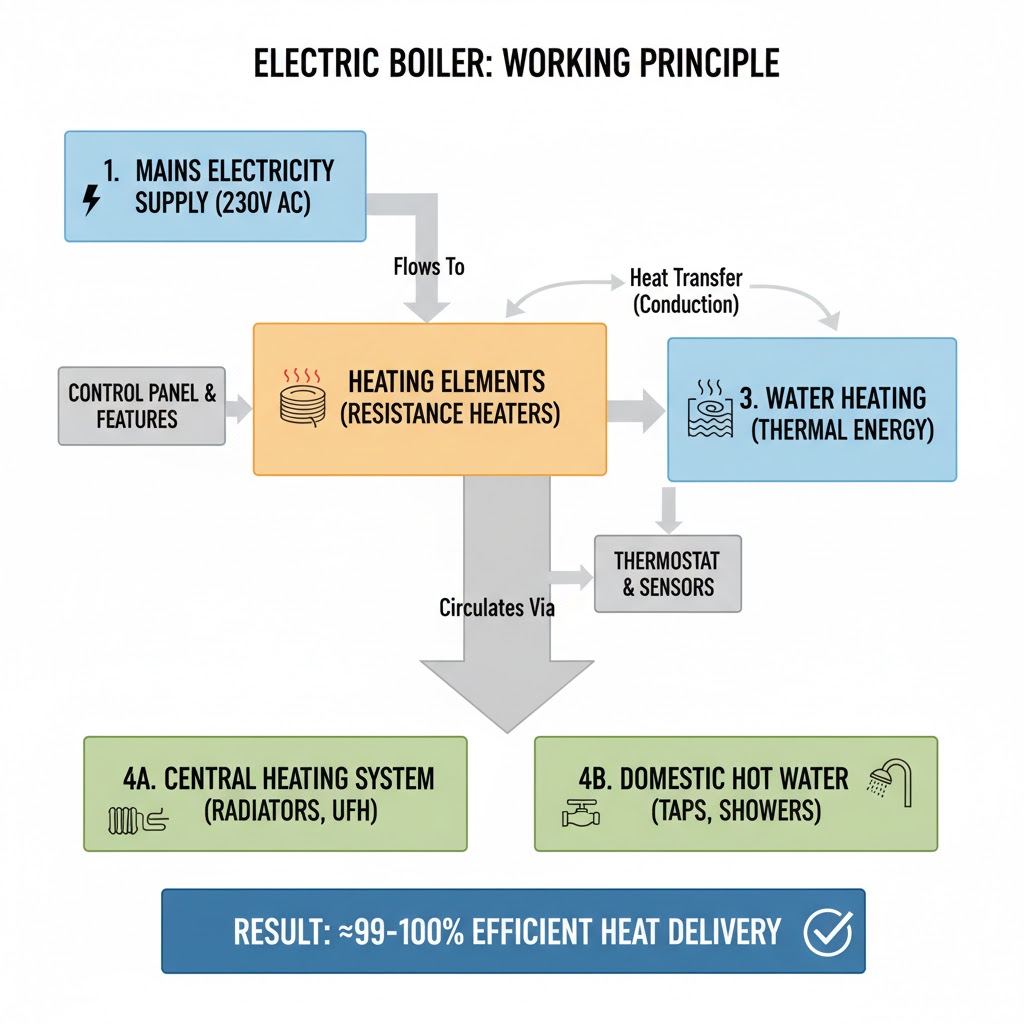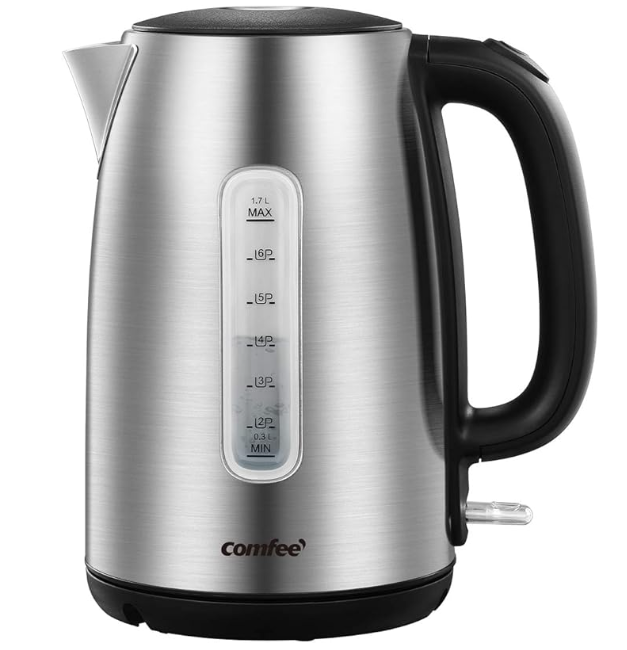
Electric boilers are rapidly emerging as a popular and sustainable heating solution for homes and businesses, offering a compelling alternative to traditional fossil fuel-burning systems. This detailed article explores the fundamental working principle, various electric boiler types, key differences from gas models, essential maintenance practices, and diverse applications.
Understanding Electric Boiler Working Principle
An electric boiler works by using electrical energy to heat water, which can then be used for central heating or domestic hot water supply. The main principle behind its operation is Joule heating, where electric current passes through a resistive heating element, converting electrical energy directly into heat. When electricity flows through the heating element, the resistance of the element causes it to heat up. This heat is then transferred to the surrounding water inside the boiler’s tank or heat exchanger.
A thermostat continuously monitors the water temperature and controls the power supply to maintain the desired level of heat efficiently. Unlike conventional boilers that burn fuel (such as gas or oil), electric boilers produce no combustion gases, making them clean, quiet, and more environmentally friendly. They are particularly suitable for areas without access to gas pipelines or for buildings aiming to reduce carbon emissions.

Types of Electric Boilers
Electric boilers come in several configurations to suit different property sizes and hot water demands:
1. Electric Combi Boilers (Combination Boilers):
Function: Provides both central heating and instantaneous hot water from a single, compact unit.
Suitability: Ideal for smaller properties or apartments with low to moderate hot water needs, as they do not require a separate hot water storage tank.
2. Electric System Boilers:
Function: Heats water for the central heating system and works alongside a separate hot water storage cylinder (tank).
Suitability: Better for medium to large homes with higher hot water demand, as they can deliver hot water simultaneously to multiple outlets. They maintain the water pressure with an expansion tank.
3. Electric Flow/Heat-Only Boilers:
Function: Provides heat solely for the central heating circuit. Requires both a hot water cylinder and a cold water storage tank (in the loft) and an expansion tank.
Suitability: Often used in older systems being converted, or as a backup heat source to complement renewable technologies like solar thermal or heat pumps.
4. Electric Storage Boilers (e.g., Dry Core):
Function: Utilizes cheaper off-peak electricity tariffs (like Economy 7) to heat a core material (like ceramic bricks) or water overnight. The stored heat is then released during peak times for central heating or hot water.
Suitability: A strategic choice in areas with significant differences between peak and off-peak electricity rates, helping to lower running costs.

Electric Boilers vs. Gas Boilers: Key Differences
The choice between an electric boiler and a natural gas boiler involves comparing fundamental differences in fuel, efficiency, cost, and environmental impact.
| Feature | Electric Boiler | Gas Boiler |
| Fuel Source | Electricity | Natural Gas (Fossil Fuel) |
| Operational Efficiency | ~99-100% (Point-of-Use) | ~90-95% (Modern Condensing) |
| Running Costs | Generally Higher (Electricity is usually more expensive per unit than gas) | Generally Lower (Gas is usually cheaper per unit) |
| Installation Cost | Generally Lower (No flue, gas line, or chimney needed) | Generally Higher (Requires gas line connection, flue, and condensate pipe) |
| Safety | Higher (No risk of Carbon Monoxide (CO) poisoning) | Lower (Risk of CO poisoning and gas leaks) |
| Environmental Impact | Zero direct emissions. Sustainability depends on the electricity generation source. | Direct carbon emissions (burning fossil fuel). |
| Maintenance | Lower and simpler (Fewer moving parts, no combustion checks) | Higher (Annual servicing is crucial for safety and efficiency) |
| Size & Space | Compact, flexible installation (no flue required) | Larger and requires external venting (flue) |
Maintenance of Electric Boiler
One of the significant advantages of electric heating is the low maintenance requirement. Without combustion, there are fewer complex components susceptible to wear and tear.
The maintenance of an electric boiler is significantly simpler and less demanding compared to fossil fuel counterparts, largely because there is no combustion involved, eliminating risks like carbon monoxide production.
Essential maintenance involves regularly checking the system’s pressure gauge, which should typically sit between 1 and 1.5 bar when cold, and promptly addressing any visible leaks or corrosion.
In areas with hard water, periodic system power flushing or descaling is crucial to prevent lime scale buildup on the heating elements, which can reduce the unit’s high energy efficiency (99-100%).
Essential Maintenance Tips
- Pressure Check: Regularly inspect the pressure gauge; it should typically be between 1 and 1.5 bar when cold. Low pressure may indicate a leak, while high pressure may require bleeding the system.
- Visual Inspection: Look for any signs of leaks, corrosion, or dripping around the unit and pipework. Address any moisture immediately.
- Descaling/Flushing: In hard water areas, lime scale can build up on the heating elements, reducing efficiency (kettling). Regular system descaling or power flushing is recommended to maintain optimal heat transfer.
- Annual Professional Service: Although less mandatory than with gas, an annual service by a qualified electrician or heating engineer is highly recommended to check electrical connections, safety devices, and overall system health, ensuring longevity.
Lifespan
Electric boilers typically have a longer lifespan than gas models, often lasting upwards of 15 to 20 years, due to their simpler design and fewer complex, wear-prone moving parts.
Advantages of Electric Boiler in Tabular form
| Feature Category | Advantage of Electric Boiler | Detailed Benefit |
| Environmental & Safety | Zero Direct Emissions | Does not burn fossil fuels, producing no $\text{CO}_2$ or $\text{NO}_x$ at the point of use. Becomes completely green when paired with renewable electricity. |
| High Safety | No risk of Carbon Monoxide ($\text{CO}$) poisoning or gas leaks, as there is no combustion process. | |
| Efficiency & Performance | Near 100% Efficiency | Virtually all the electricity consumed is converted directly into useful heat, minimizing energy waste. |
| Quiet Operation | Operates very silently compared to gas boilers, which have noisy fans and combustion processes. | |
| Installation & Maintenance | Lower Installation Cost | Does not require a flue, gas line connection, or condensate pipe, simplifying installation and reducing labor costs. |
| Flexible Placement | Can be installed almost anywhere in the property (kitchen, cupboard, loft) as long as there is an electrical supply. | |
| Minimal Maintenance | Has fewer moving parts (no pumps, gas valves, or burner) and no combustion checks required, leading to simpler, less frequent, and cheaper servicing. | |
| Longer Lifespan | Typically lasts longer (15-20 years) due to the simpler, robust design and less stress from combustion. | |
| Accessibility | Suitable for Off-Grid Homes | An excellent primary heating solution for properties that have no access to the mains gas network. |
Primary Electric Boiler Applications
Electric boilers are incredibly versatile and are utilized across a variety of settings where a compact, safe, or clean heat source is paramount.
- Small to Medium Residential Properties: They are an excellent main heating source for flats, apartments, and small-to-medium houses, especially where there is no access to a mains gas supply (off-grid homes).
- New Construction & Highly Insulated Homes: In modern, low-energy buildings with minimal heat loss, the lower initial cost and high efficiency of an electric boiler can make it a very cost-effective and environmentally sound choice.
- Backup and Supplementary Heating: They are frequently used to support existing heating systems, such as providing boost heating for a heat pump during peak demand or extreme cold, or integrating with solar PV generated electricity.
- Commercial and Industrial Use: Smaller electric steam boilers are used in laboratories, hospitals, and food processing where a clean, localized steam source is required without the need for flues or fuel storage.
